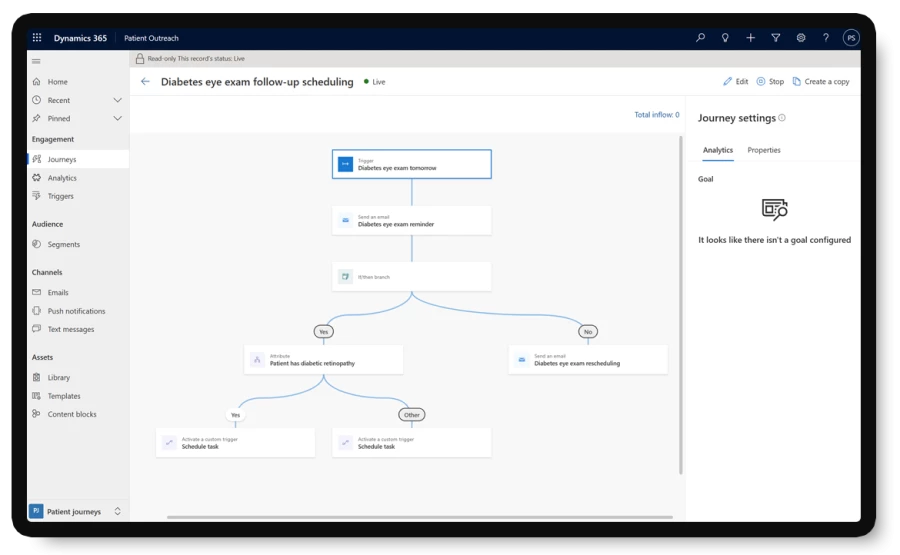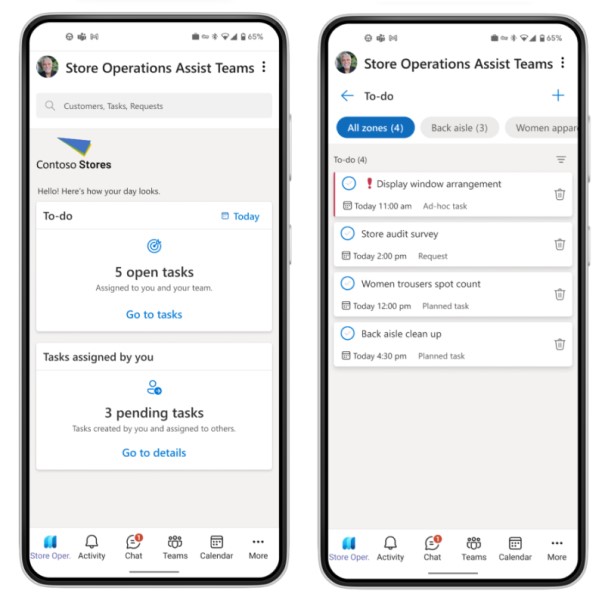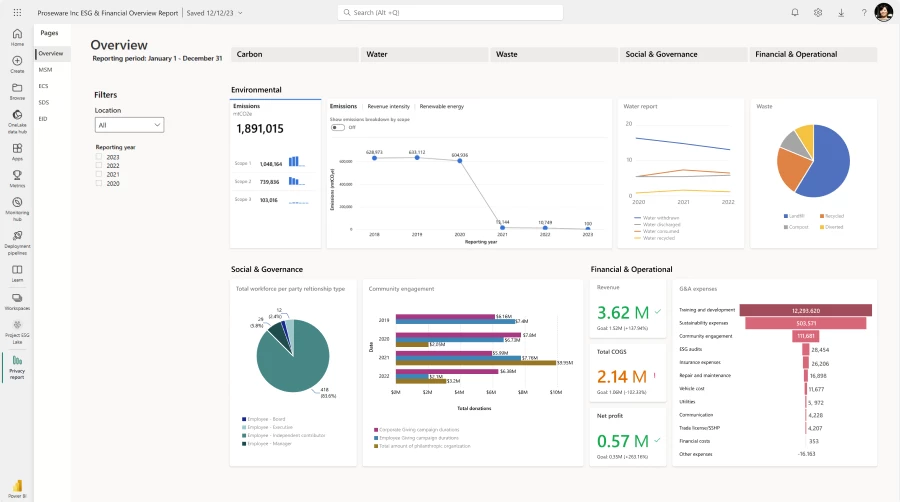
Innovating with Microsoft Industry Clouds next release wave
In the face of an ever-changing and dynamic market, Microsoft Industry Clouds are helping customers and partners across multiple industries thrive. We’re delivering technological innovation to help every organization build resilience to weather uncertainty and accelerate digital transformation.
New capabilities within the 2023 release wave 2—coming available from October 1, 2023, to March 31, 2024. Partners are critical to the success of our Microsoft Industry Clouds. These innovations represent our collaboration with partners across industries who build and extend these solutions, enabling high-value scenarios for our customers. During this wave, we’re offering richer, more data-driven precision, and new personalized experiences for customers and employees to advance decision making for business growth. You can see the full details about what’s new and planned in our release plans on Microsoft Learn. Let’s take a look at what’s in store for the coming months.

Microsoft Cloud for Industry 2023 release wave 2 plan
Learn about the latest updates for customers
Microsoft Cloud for Healthcare
More than ever, patients expect to be active participants in their health and wellness. Personalized care management solutions help engage patients in care decisions, improve care outcomes, and increase patient satisfaction, while also improving operational efficiency and the bottom line. With the wave 2 release of Microsoft Cloud for Healthcare, we aim to help healthcare providers deliver a real-time, seamless, and personalized experience to patients. Healthcare organizations will be able to more efficiently deliver customized patient outreach developing journeys—from initial awareness through ongoing care management. By enabling data access with a wider range of sources, organizations have more flexibility to drive patient engagement, both directly and with interoperable partner solutions.

Care management and collaboration are foundational for quality, patient-centric care. To mitigate fragmented communications, siloed data, and incomplete information that can challenge health teams to see the full picture, this release wave now extends to payors. By expanding care management capabilities, Microsoft Cloud for Healthcare can help healthcare organizations reduce the administrative burden of staying up to date on member health and care delivery—simplifying workflow management, automating tasks, and expediting new member onboarding. This means better cost control while also improving member satisfaction and quality of care.
To further simplify compliant data sharing across systems and accelerate innovation, we’re focused on making it easier to build Fast Healthcare Interoperability Resources® (FHIR®) applications. Microsoft Cloud for Healthcare solutions are being extended with new functionality for developers at all levels: from low-code, pre-built templates and tooling for citizen developers building Microsoft Power Platform healthcare applications to advanced capabilities unlocking the potential of model-driven applications with data from Microsoft Azure Health Data Services and Virtual Health Data Tables.
Our investment in application integration is further improving virtual health, working with leading independent software vendor (ISV) Teladoc Health to better integrate Microsoft Teams with its virtual health platform, Solo™, for hospitals and health systems, streamlining clinician access to telehealth within existing workflows. We’re making it easy to offer high-quality virtual medical care visits that are compliant with industry standards while having a secure and streamlined platform for seamless communication and collaboration across: chat, video, voice, and even AI health bots and other care management tools.
Microsoft Cloud for Retail
Maintaining efficient and resilient store operations is a key part of successful retail. Microsoft Cloud for Retail offers store associates on-demand access to the data, insights, and tools necessary to effectively engage with customers to offer personalized assistance and a seamless shopping experience. Greater information access also means store associates can self-service tasks to stay productive throughout shifts, while allowing district and store managers to direct store operations more effectively.
What is Store operations assist?
Watch the videoImprovements to our retail workforce management capabilities within store operations assist can help retailers improve efficiency and their bottom line. Using store operations assist in Microsoft Teams, store associates have a single pane-of-glass experience to manage their day. Store employees can perform inventory checks and act on urgent notifications, such as product recalls. Managers can assign training and learning tasks to employees as well as confidential tasks, such as shift planning and performance reporting. Finally, district leaders can detect anomalies, uncover patterns, and ask questions using natural language AI capabilities to identify root cause and corresponding mitigations to improve store performance.

In the coming months, we’ll further invest in driving data gravity and bringing in rich, new data sources the Microsoft Intelligent Data Platform for retailers, bringing in rich, new data sources and applications. We’re also excited to further harness the power of AI and machine learning to help our customers gain a competitive edge, integrating new insights to create a cohesive and efficient experience for retailers. We also continue to work with partners such as AiFi to infuse AI and bring these solutions to market.
Microsoft Cloud for Sustainability
Microsoft Cloud for Sustainability solutions from Microsoft and our global partners help advance ambitious sustainability goals by providing organizations with a digital foundation to help them enable environmental, social, and governance (ESG) data intelligence, deliver sustainable IT infrastructure, improve ESG performance, and unlock sustainable growth. We know that organizing and integrating the data required to calculate an organization’s environmental footprint can be challenging. Microsoft Cloud for Sustainability helps companies overcome complexity by enabling a blend of manual and automated data ingestion methods to collect and centralize their data across the business. Upcoming frameworks for third-party connectors will help customers efficiently import data from their partners and vendors into Microsoft Sustainability Manager. In addition, new calculations and data integration for water and waste will help companies extend their progress beyond carbon.
With Project ESG Lake (preview), organizations gain an expansive ESG data model to better manage and prepare data for faster, more holistic analysis using advanced analytics and insights. Greater visibility into activities across the business helps decision makers improve ESG and business performance while empowering innovation for long-term competitiveness.

CSRD template in Purview Compliance Manager
Learn moreFor organizations facing new regulatory requirements like those based on the European Union Compliance Sustainability Reporting Directive (CSRD), new reporting templates can help with ESG reporting readiness. And upcoming AI-driven “what-if” scenario analysis and anomaly detection can help generate new insights to inform strategy—for example, allowing customers to quickly model how transitioning to a renewable energy source or a new energy supplier could impact their overall carbon footprint.
Our new ESG value chain solution helps organizations build a richer view of the upstream and downstream impacts that vendors and partners have on their environmental footprint and simplifies Scope 3 calculations. Using the solution, organizations can simplify the collection and reporting of detailed data about the sustainability activities of value chain partners, track data across carbon, water, and waste factors, and feed approved data directly into Sustainability Manager. With a transparent understanding of each other’s positions, our customers can better collaborate to drive efficiency, reduce emissions, and design out waste.
We continue to build solutions with partners such as Ecovadis and Ecolab. We also continue to work with trusted advisers like Accenture, Avanade, Capgemini, EY, KPMG, and PwC who are helping organizations everywhere plan, design, and implement strategies and robust solutions to enable transformation.
The Well-Architected for Microsoft Cloud for Sustainability resources have been updated with a focus on data management and Sustainability Manager implementation journey, introducing best practices to build reliable, secure, cost-optimized, operationally excellent, and performance-efficient Sustainability Manager workloads. The new updates are aimed at meeting the persistent demand for implementation guidance from customers and partners using a framework to evaluate important design considerations and their tradeoffs.
Microsoft Cloud for Nonprofit
Upcoming functionality within Microsoft Cloud for Nonprofit can help better position nonprofit organizations to take advantage of data analysis and insights at every level: from lightweight Modern Work templates and dashboards to streamline data management and allow customers to get straight to the insights to advanced data quality assessments that can determine whether the organization is ready to integrate AI and machine learning models—and help with remediation suggestions for the most common data quality issues. With upcoming functionality, Microsoft Cloud for Nonprofit can help unify data across fundraising, programs, finance, operations, and other disparate sources—in the back-office and on the frontline. With this unified view, organizations can build a better understanding of which supporters are most likely to engage through which channels and use AI to predict which constituents are most likely to donate based on different attributes. This can help outreach and marketing engagement teams work most effectively to support their mission.
Nonprofits will also benefit from faster and more secure donation processing. As we continue to invest in leveraging Microsoft platform capabilities, we’re further redesigning the architecture of fundraising and engagement functions to ensure Microsoft Azure is delivering real-time processing and market-leading transaction security. Nonprofit organizations using Dynamics Customer Insights and Microsoft Cloud for Nonprofit will see new marketing templates to help with data-driven constituent management, personalized engagement and donation, and award management.
Microsoft Cloud for Sovereignty
As governments innovate with technology, addressing the rapidly evolving demands of their citizens while protecting sensitive data and delivering promises of trust and security is needed. Modernization of government services without compromising security, digitization of manual processes, and improved user experiences for both citizens and government employees are all benefits of digital transformation. Governments know that the right technology platforms can create even better opportunities for social and economic growth.
Sovereignty can mean many things in different contexts. Within the context of the Microsoft approach to data sovereignty, we give government customers full control over their data. The control may include data residency within regional boundaries and tools to ensure control of who has access to their data.
Data sovereignty is critical for governments to:
- Protect government data from security breaches and malicious activity.
- Maintain government data confidentiality to protect privacy.
- Protect government data against unauthorized access to data.
- Secure government data to prevent negative business and financial impact.
We recently launched Microsoft Cloud for Sovereignty (preview) and will continue to iterate toward general availability during this wave. See the latest and learn more at Microsoft Cloud for Sovereignty.
More innovation to come across industries
Beyond the new capabilities we’ve just previewed, we continue to invest across key verticals, including making generative AI easier with Microsoft Cloud for Financial Services and Microsoft Cloud for Manufacturing, as well as industry-specific cloud solutions like Azure Data Manager for Energy and Azure Data Manager for Agriculture. Follow us on Industry Cloud blogs for industry-specific news and read more about what’s upcoming on our documentation pages.
Catch us at Microsoft Ignite, from November 14 to 17, 2023 to see some of these capabilities and connect with our team.
Note: Some of the functionalities described in this release plan has not been released. Delivery timelines may change, and projected functionality may not be released (see Microsoft policy).
For a list of the countries or regions where Dynamics 365 business applications are available, go to the International availability guide. For more information about geographic areas and datacenters (regions), go to the Dynamics 365 and Microsoft Power Platform availability page.




![[4:56 PM] Jordan Davis (Wipro Designit Services, Inc.) Green background with colored swoops on the top and an image of a young adult helping older adult with a computer.](https://www.microsoft.com/en-us/industry/blog/wp-content/uploads/2024/04/MSFT_Azure_APR08_328468_Blog_Blogheader_240408_V01-1-300x169.webp)